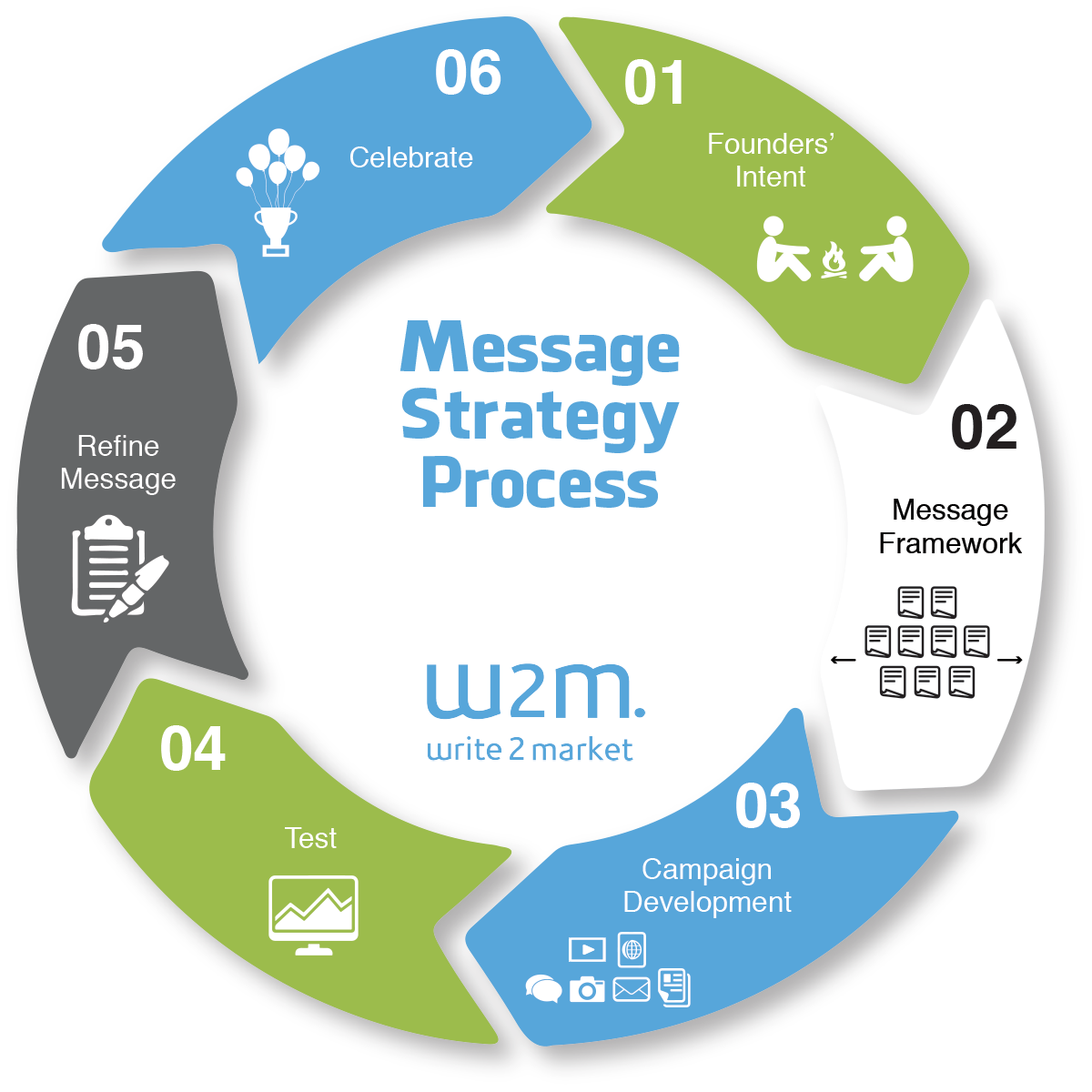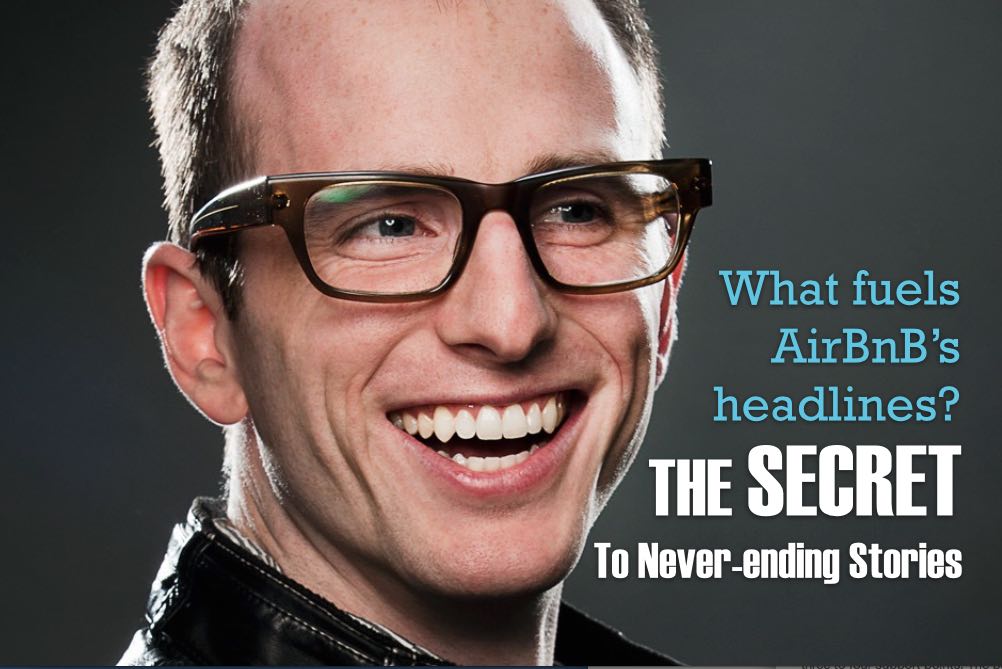Does this sound familiar?
You have an amazing story on your hands. You call editors at the top news outlets, and they pick it up! Champagne and celebration flow with the deluge of coverage: the feature in Fortune, the byline in Wired, the write-up in Tech Crunch, the Harvard Business Review op-ed, the piece in your local weekly, the short on CNN…
Until the next week arrives and… Crickets. You no longer have a story running in top outlets. You wonder, where is your next story going to come from?
Beating the Boom/Bust PR Cycle
Now your PR team feels less like partygoers and more like backwoods campers in July—sweating it. Where is your next story coming from? How can things go from boom to bust so quickly?
It doesn’t have to be this way. A little discipline, and you’ll have a steady, five-star publicity experience. The answer to the boom/bust story cycle is simple. The secret? Mining a message strategy cycle.
Message Strategy for Public Relations
Our six-step message strategy process is what we use to keep the stories coming. It starts a little sooner than a story idea or campaign, and goes beyond the story running, into testing the story, and then refining and potentially recycling it further.
Let’s take a deeper look at the steps in WriteMarket’s Message Strategy Cycle and see if you can make it yours!

Step One: Founder’s Intent

Joe Gebbia, co-founder of AirBnB
Businesses need to tell a story, and every business’s story is born from the founder’s intent. What was he or she aiming to accomplish by starting their business? How did they accomplish it? It’s amazing how simple these stories can be!
For example, this morning, I got to sip coffee with Joe Gebbia, the co-founder of AirBnB. He said, “AirBnB was started, and exists, so that you can belong anywhere.” Hard to miss the story there, huh? The founder’s intent creates a story.
Joe went on to talk about how, when investors wouldn’t back them over the first years, they were fueled to persevere because he and his cofounder truly believed in their mission. He’s excited that AirBnB now offers 1,000+ places to stay in Cuba—as AirBnB expands, they add more and more credence to their founder’s original intent: creating a platform to help people belong anywhere.
Step Two: Message Framework
The next step in creating an “endless story cycle” is to take a company’s core values and frame them into a position statement. Message position statements are short paragraphs that lay out a company’s core values with the key points of evidence and identity. This is necessary because a founders’ intent alone is not compelling without context and evidence like:
• Vision or Mission
• Sandbox (a test environment, i.e. “U.S. or “West Coast” or “global”)
• Key audiences (like “HCM Managers” or “Financial Planners” or “CMOs”)
• Headquarters or Locations
• Date of founding
• Financial growth
• Number of employees
• Key customers
• Reference to any proprietary index data or methodology the company has
With this key info condensed into a short position statement, media outlets have all they need to get on board with your story.
Step 3: Developing Campaigns
Now that you’ve got all your key information, you’re ready to develop a story! With a strategic framework of information, you can create email campaigns, ebooks, webinars, and more! The essence of the founder’s intent and message framework allows for an endless well of inspiration. But being able to create public relations campaigns are the most important for securing coverage from top outlets.
To create engaging public relations outreach, you’ll want to answer these questions:
1) Who are most relevant target audiences? One story idea can be mined three or four ways by pursuing different audience angles.
2) Which brands are influential to this business? Brand tie-ins are great ways to re-angle a basic story.
3) What do they need to know in order to choose us? There are often a handful of issues that, if your audience knew, would lead customers to your company. How does your company appeal to the day’s trends? To your audience’s pain points? Pursuing these is a significant story geyser.
4) Who can back up your claims? Sharing your clients’ stories, when they attest to your core values, is one of the big secrets of endless storytelling. Here’s a quick primer on how to get your clients involved in sharing your story: Three Secrets To Writing Case Studies Right.
5) What unique data can we share to underscore our story? Using hard facts and data to back your heartfelt storytelling is a terrific way to keep stories flowing. They’ll only believe your story if you have the irrefutable evidence to back it up.
Step Four: Message Testing
Your never-ending story cycle isn’t complete without analyzing its performance, or “message testing,” as we call it. You can learn more about testing your message in this blog post on marketing metrics.
Step Five: Refine Your Message
Step Two, creating a message framework, is not a one-and-done step, unfortunately. It will take some trial and error to find the strongest possible message for your brand. The first or second or third message framework you create may deliver adequate PR results, but never get complacent. Keep tweaking and refining until you have a message that resonates with audiences and pulls in the PR returns that give cause for celebration. Which brings us to our final step…
Step Six: Celebrate!
After five challenging steps (which may have each been repeated a few times), you’ve finally created the PR story cycle of your dreams and beat the boom/bust cycle. The only thing that should be busting now is the cork of your champagne bottle! Celebrate your success!

